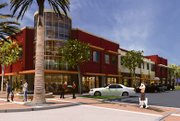Retail Is the Rising Star in the Inland Empire
California’s Inland Empire has long been known as the warehouse empire of the West, but for the first time in years, retail real estate investment is outpacing industrial sales, indicating that retailers are finally making a serious move into the region, located about 90 miles east of Los Angeles, said analysts.
Warehouse property sales during the first quarter raked in $188 million, compared with $192 million for retail investments and $217 million for apartment and multifamily transactions, according to Real Capital Analytics, a Concord, Calif.–based researcher.
Retailers in the past have been holding back on expanding into the Inland Empire, but zooming population growth has created a demand that has outpaced supply, so the rush is on to move east, even for more upscale chains, said real estate experts.
“Victoria Gardens [in Rancho Cucamonga, Calif.] wasthe game changer,” noted Jack Kyser, senior economist for the Los Angeles County Economic Development Corp. Specialty retailers such as Nordstrom, which has committed to another unit in California’s Coachella Valley, offer validation that the Inland Empire market can’t be overlooked. Lifestyle center Victoria Gardens—whose latest tenants include Los Angeles–based Planet Funk, Lucky Brand and Jaloux—has upped the ante in the Inland Empire with a slate of more upscale retailers than the area is used to, featuring stores including Anthropologie, Hollister, Abercrombie & Fitch and others.
As a result, there’s also some polarization taking place with more upscale retailers moving into the western portion of the region and discounters and power centers on the eastern perimeters, explained Dain Fedora, research manager for Grubb & Ellis real estate.
“While you’re seeing the lifestyle centers being built up, you’re also seeing a proliferation of Wal-Marts,” he said.
Aside from Victoria Gardens, other projects—including The Shoppes at Chino Hills, a 1 millionsquare- foot outdoor lifestyle shopping center in Chino Hills, Calif.—are being developed. Ann Taylor, Banana Republic, American Eagle, Coldwater Creek, J. Jill and PacSun have already signed leases. The Galleria at Tyler is undergoing a 200,000-square-foot expansion, adding restaurants such as P.F. Chang’s. The Promenade Shops at Dos Lagos in Corona, Calif., opened last fall. G by Guess will join Talbots, Coach and White House/Black Market.
Fedora said another interesting aspect of growth is the proliferation of smaller boutique shopping emporiums featuring more specialty stores and nightlife venues aimed at younger crowds.
The population growth in the Inland Empire has of course been fueled by more affordable housing, but as housing growth slows, analysts don’t expect retail growth to be affected that much.
“It may take a little of the edge off, but savvy retailers will still be looking far out into the future because they know it will become tougher to get good locations,” said Kyser.
“People are still getting three times the house out there, so any slowdown in housing is less likely to create a domino effect,” added Georg Whalen, president of Carlsbad, Calif.–based Retail Management Consultants. “It’s a very good marketplace.”
Kyser said the retail competition will heat up, with big grocery chains such as United Kingdom–based Tesco PLC and WinCo Foods grabbing lots of real estate. Vacancy rates are currently averaging 6 percent, said Fedora.
Consumers in the region do have the spending power. In markets such as Chino Hills, the average household income is just under $100,000. Unemployment, at 4.6 percent last year, was at its lowest level in 40 years. Almost 50,000 jobs were added to the two-county region, a 4 percent growth rate, well ahead of Los Angeles County’s 1.7 percent growth rate and Orange County’s 1.9 percent. Almost one-fifth of all jobs created in California were in the Inland Empire.
Economists are projecting the trend will continue and anticipate about $52 billion in retail sales this year, up 11 percent. The state Employment Development Department projects that about 320,000 new jobs will come to the region by 2012, indicating that retail will play a big part in the growth.























